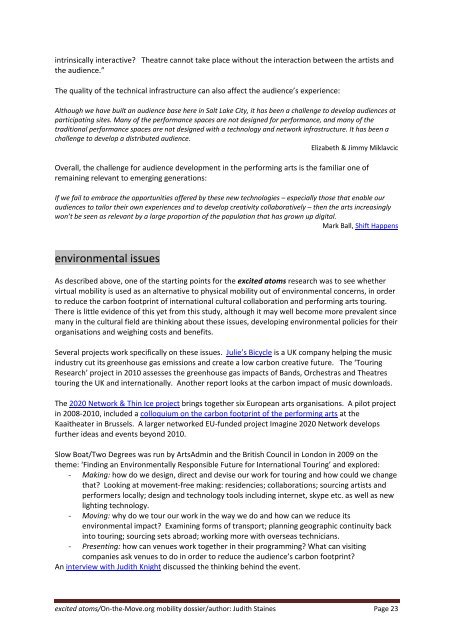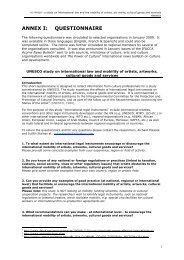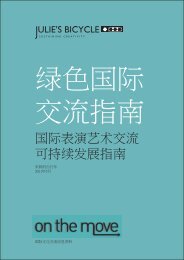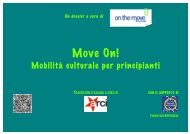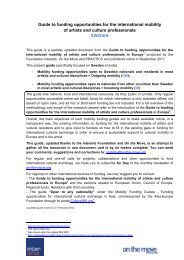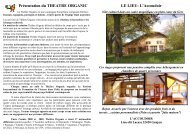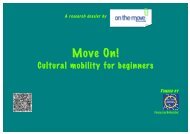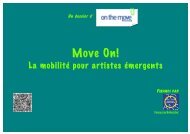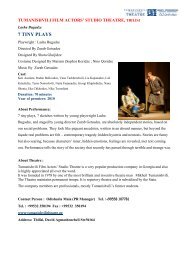DOWNLOAD Excited Atoms - On the Move
DOWNLOAD Excited Atoms - On the Move
DOWNLOAD Excited Atoms - On the Move
Create successful ePaper yourself
Turn your PDF publications into a flip-book with our unique Google optimized e-Paper software.
intrinsically interactive Theatre cannot take place without <strong>the</strong> interaction between <strong>the</strong> artists and<br />
<strong>the</strong> audience.”<br />
The quality of <strong>the</strong> technical infrastructure can also affect <strong>the</strong> audience’s experience:<br />
Although we have built an audience base here in Salt Lake City, it has been a challenge to develop audiences at<br />
participating sites. Many of <strong>the</strong> performance spaces are not designed for performance, and many of <strong>the</strong><br />
traditional performance spaces are not designed with a technology and network infrastructure. It has been a<br />
challenge to develop a distributed audience.<br />
Elizabeth & Jimmy Miklavcic<br />
Overall, <strong>the</strong> challenge for audience development in <strong>the</strong> performing arts is <strong>the</strong> familiar one of<br />
remaining relevant to emerging generations:<br />
If we fail to embrace <strong>the</strong> opportunities offered by <strong>the</strong>se new technologies – especially those that enable our<br />
audiences to tailor <strong>the</strong>ir own experiences and to develop creativity collaboratively – <strong>the</strong>n <strong>the</strong> arts increasingly<br />
won’t be seen as relevant by a large proportion of <strong>the</strong> population that has grown up digital.<br />
Mark Ball, Shift Happens<br />
environmental issues<br />
As described above, one of <strong>the</strong> starting points for <strong>the</strong> excited atoms research was to see whe<strong>the</strong>r<br />
virtual mobility is used as an alternative to physical mobility out of environmental concerns, in order<br />
to reduce <strong>the</strong> carbon footprint of international cultural collaboration and performing arts touring.<br />
There is little evidence of this yet from this study, although it may well become more prevalent since<br />
many in <strong>the</strong> cultural field are thinking about <strong>the</strong>se issues, developing environmental policies for <strong>the</strong>ir<br />
organisations and weighing costs and benefits.<br />
Several projects work specifically on <strong>the</strong>se issues. Julie’s Bicycle is a UK company helping <strong>the</strong> music<br />
industry cut its greenhouse gas emissions and create a low carbon creative future. The ‘Touring<br />
Research’ project in 2010 assesses <strong>the</strong> greenhouse gas impacts of Bands, Orchestras and Theatres<br />
touring <strong>the</strong> UK and internationally. Ano<strong>the</strong>r report looks at <strong>the</strong> carbon impact of music downloads.<br />
The 2020 Network & Thin Ice project brings toge<strong>the</strong>r six European arts organisations. A pilot project<br />
in 2008-2010, included a colloquium on <strong>the</strong> carbon footprint of <strong>the</strong> performing arts at <strong>the</strong><br />
Kaai<strong>the</strong>ater in Brussels. A larger networked EU-funded project Imagine 2020 Network develops<br />
fur<strong>the</strong>r ideas and events beyond 2010.<br />
Slow Boat/Two Degrees was run by ArtsAdmin and <strong>the</strong> British Council in London in 2009 on <strong>the</strong><br />
<strong>the</strong>me: ‘Finding an Environmentally Responsible Future for International Touring’ and explored:<br />
- Making: how do we design, direct and devise our work for touring and how could we change<br />
that Looking at movement-free making: residencies; collaborations; sourcing artists and<br />
performers locally; design and technology tools including internet, skype etc. as well as new<br />
lighting technology.<br />
- Moving: why do we tour our work in <strong>the</strong> way we do and how can we reduce its<br />
environmental impact Examining forms of transport; planning geographic continuity back<br />
into touring; sourcing sets abroad; working more with overseas technicians.<br />
- Presenting: how can venues work toge<strong>the</strong>r in <strong>the</strong>ir programming What can visiting<br />
companies ask venues to do in order to reduce <strong>the</strong> audience’s carbon footprint<br />
An interview with Judith Knight discussed <strong>the</strong> thinking behind <strong>the</strong> event.<br />
excited atoms/<strong>On</strong>-<strong>the</strong>-<strong>Move</strong>.org mobility dossier/author: Judith Staines Page 23


